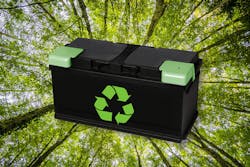New Approaches Promise to Improve Large-Scale Battery Recycling
By the end of 2020, 17.6 GWh of Li-ion batteries had reached their end of life; by 2035, this figure will balloon to more than 140 GWh. However, existing battery recycling infrastructure isn't optimized to either handle end-of-life battery capacity or meet critical materials demands as electrification ramps up.
Historically, most battery recycling efforts offered low recovery rates for cathode active materials while consuming unsustainable amounts of energy and chemicals to do so, but new approaches have opened the door for large-scale battery recycling, according to new data from Lux Research, a provider of tech-enabled research and innovation advisory services.
Lux's new report, "Clear-Cut Opportunities in Battery Recycling," evaluates battery recycling opportunities for chemical and materials companies, cathode manufacturers, and automotive OEMs and examines emerging startups and where they fit along the traditional battery value chain.
Although battery recycling is not a new technology, the innovation space for Li-ion battery recycling is active. Developers are concentrating on increasing the recovery rates of battery materials and especially higher-purity materials to maximize the value of recycled products.
Companies eager to join the battery recycling industry have multiple possibilities for entry. Partnerships are crucial for all players along the battery value chain, and that's true too for entrants in battery recycling.
"The driving factors for recycling development are numerous," explains Abhirabh Basu, Analyst at Lux Research and lead author of the report. "Policy is emerging as an important safeguard against environmental hazards associated with battery disposal, economic development of recycling will benefit almost all players along the battery value chain, and technology for Li-ion battery recycling has improved to the point that recyclers claim recovery rates upward of 98%."
Despite a flurry of activity in the past few years, battery recycling remains limited by both technological and economic factors. The industry has historically been buoyed by high-cobalt-content consumer electronics batteries, but as electric vehicle batteries begin dominating Li-ion waste streams, recyclers will have to process diverse cathode chemistries at higher volumes. This ongoing shift toward battery recycling will impact every player across the Li-ion battery value chain.
